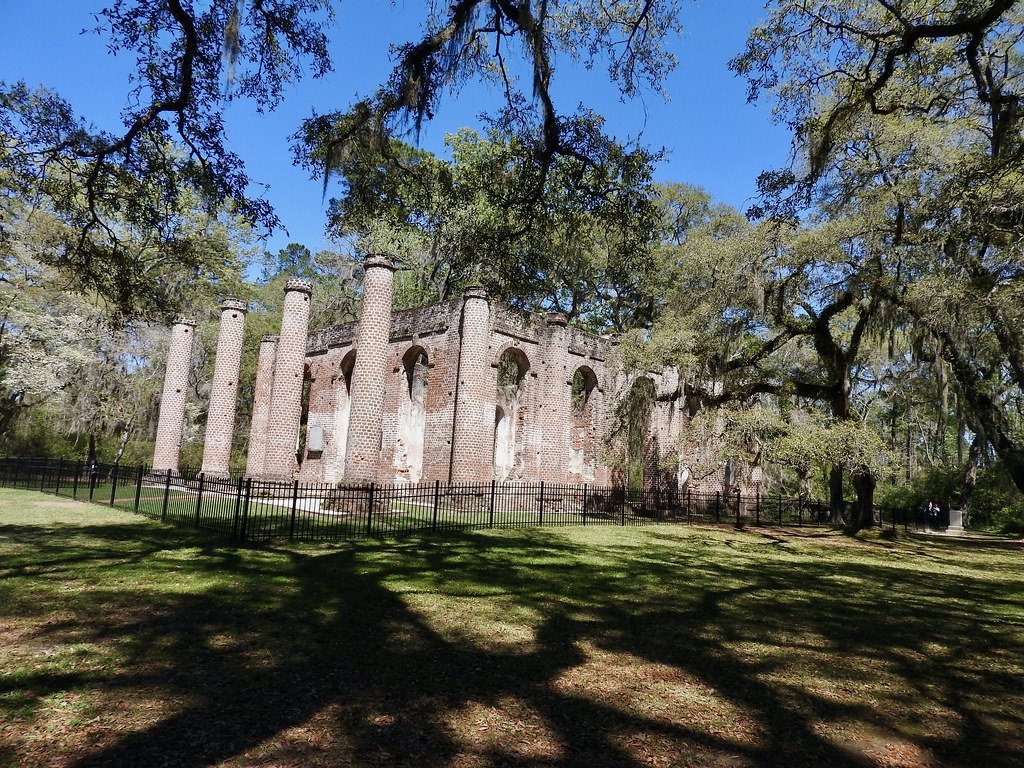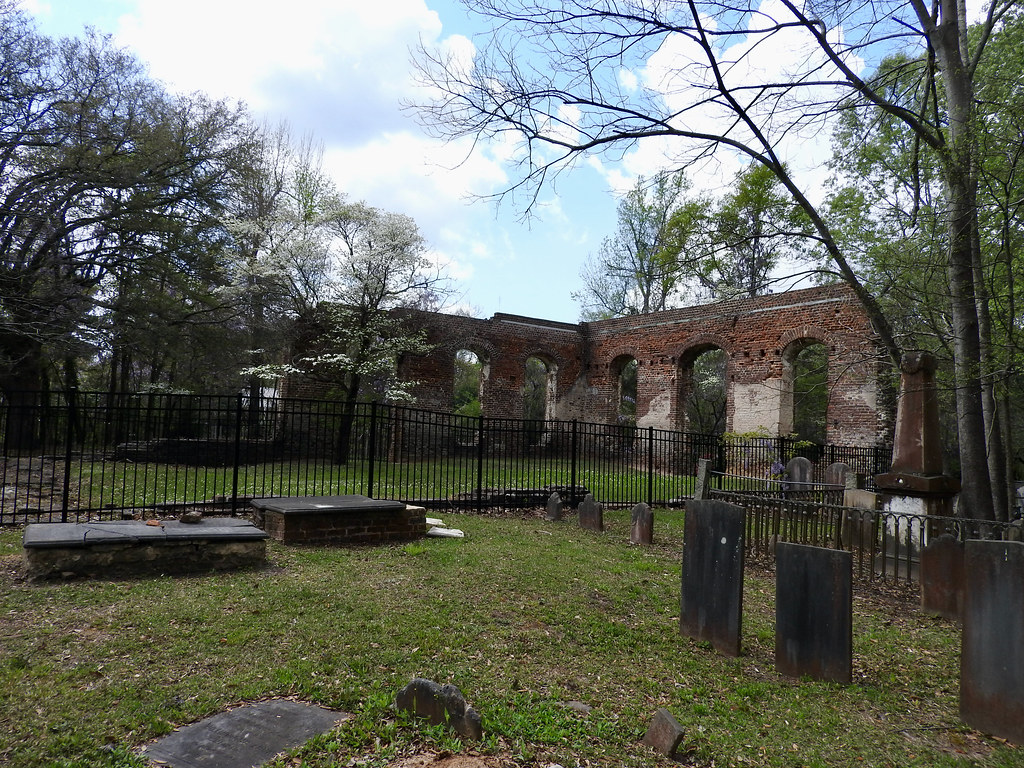South Carolina sure loved its old buildings whether lovingly maintained or reduced to rubble. In particularly her people revered historic churches with their requisite cemeteries filled with live oaks and draped in Spanish moss.
Old churches and weathered cemeteries became a recurring theme on my journey. Or sometimes just the family cemeteries of long-lost plantations in the middle of a field where nothing else remained. It’s not like I went out of my way or anything. I’m not morbid. There were just so many of them.
Old Sheldon Church

Naturally I have to start with the Old Sheldon Church because it’s the quintessential South Carolina ruin (map). Just take a look. It includes all of the necessary features in wonderfully preserved decay. I simply loved those columns and the live oaks and the beautifully manicured grounds. It simply screams Lowcountry charm, doesn’t it? The geographic placement helps make it popular too, with easy access to romantic weekends in Beaufort.
This Anglican church in its initial form began in the 1750’s. However, in a familiar story, British and Loyalist troops set it ablaze during the Revolutionary War. Rebuilding followed and then came the Civil War. An historical marker at the site explains that local freedmen dismantled much of the church after the war. That contradicted legends of the Union army burning it. Either way it remained a ruin ever since.
Pon-Pon Chapel of Ease

First, what is a chapel of ease? I had to look it up. So apparently it’s:
“…a church building other than the parish church, built within the bounds of a parish for the attendance of those who cannot reach the parish church conveniently.”
You’re on your own for the Pon-Pon part. One source claimed it was a Native word for “big bends” referring to the nearby Edisto River. True or not? Who knows.
This chapel of ease (map) sat along Parker’s Ferry Road, a well-traveled route between Charleston and Savannah when the chapel held its first service circa 1725. Then the parish replaced it with a brick church that subsequently burned around 1800. So they built another replacement and that one fell sometime around 1830. Then they gave up. The remains have been gradually wearing away ever since. The road didn’t fare much better either; the short portion leading to the chapel is barely paved and the rest is a dirt track. It’s no route between anything anymore.
Pon-Pon also featured some minor historical significance. The Rev. John Wesley, who founded the Methodist movement, preached two sermons at the original chapel in 1737.
Biggin Church

Another abandoned church, another strange name. Biggin, anyone? Well I tried to figure that one out too. There’s some speculation around the designation. The church sits atop a slight incline that passes for a hill in these parts (map). Thus, “The site for the church, Biggin Hill, is probably named for Biggin Hill in the London Borough of Bromley.”
And what about that hill in London? There’s some speculation here too, with even less certainty. It may derive “from a hilltop ‘bigging’ or habitation and was first recorded – as Byggunhull – in 1499.” Eh, maybe. Sounds pretty tenuous. That still didn’t explain nearby Biggin Creek so what was named for what exactly down there in South Carolina? But I digress.
I did learn from the nearby historical marker that the ruins I explored actually represented Biggin Church #4. Here’s the basic chronology:
- The original church was a log structure at the turn of the 18th Century. It lasted until 1710/15-ish until replaced by something more befitting the parish church of St. John’s Berkeley Parish.
- That nice brick structure lasted until 1755 when a forest fire burned it to the ground.
- So they built again, reopening ~1767, and that lasted until 1781 when the British burned it.
- They gave it another go but another forest fire came through sometime just before the turn of the 20th Century and it burned once again. That was it. No more.
Thus I stood on the grounds of the fourth and final incarnation of the Biggin Church ruins.
Robert Smalls Grave

It was nice to see a cemetery next to an actual functioning church after my other adventures. This was the Small family plot at the Tabernacle Baptist Church on Craven Street, in Beaufort (map). This one came with a memorial to one of the people interred there; Robert Smalls. It offered a quote.
“My race needs no special defense. For the past history of them in this country proves them to be the equal of any people anywhere. All they need is an equal chance in the battle of life”
Robert Smalls; November 1, 1895
Robert Smalls started life in Beaufort as a slave and became a well-known historical figure by the time he passed away in 1915.
Civil War
During his teens and early twenties, his master rented him out for various jobs including stints down at the Charleston wharf. There he learned the intricacies of the harbor and the necessary skills to steer a ship.
The Civil War broke out in 1861 and Confederates used slaves as labor on many of their ships. Thus they ordered Smalls to steer the CSS Planter, a military cargo steamer along the South Carolina coast. He continued to earn trust for the next year and then he and other slaves on the ship hatched a plot.
The White officers went ashore one night so Smalls and his crew brought their families aboard and sailed to freedom. He knew the harbor codes so the Confederate coastal forts simply let him pass. He reached the Union blockade before anyone figured it out. Then Smalls joined the Union navy and became the first Black man to command a U.S. naval ship, and served for the remainder of the war. The story is actually a lot more interesting than what I can describe in a couple of short paragraphs.
Reconstruction
Smalls returned to Beaufort after the war and became a businessman and a politician. Most significantly he served in the U.S. House of Representatives for several terms in the 1870’s and 1880’s. Throughout his remarkable life he always fought to put African Americans on equal footing with those would would oppress them.
Isaac Hayne Tomb

The Isaac Hayne tomb sat less than a half-mile from the Pon Pon chapel of ease as far as the crow flies. However I wasn’t a crow. Instead, I had to loop around and then drive up a particularly rutted and poorly maintained dirt road (map). Thank goodness I had 4-Wheel Drive although I didn’t actually need to use it. Then I arrived at an immaculately maintained plot that marked the family cemetery of the former Hayne Hall Plantation.
Here lay Colonel Isaac Hayne, a martyr of the American Revolution. He was one of many soldiers captured after Charleston fell to the British in 1780. His situation became rather convoluted although essentially Hayne signed a British oath of allegiance so he could return home to be with his family and help them through a smallpox outbreak.
Then, a few months later with American forces surging and the British bottled-up in Charleston, the British called up Hayne to help defend the city. Instead Col. Hayne rejoined the Continental Army. Soon the British captured him and this time they considered him a traitor rather than a prisoner of war. So they hanged him in August 1781.
Americans fighting for independence considered this an outrage and used it as a highly effective propaganda tool. It galvanized opposition to British rule in South Carolina in the waning days of the war.
Addendum
There was also the Gen. Francis Marion tomb but I talked about that one in the previous article.
Articles in the Carolina Wetlands Series
- Padding the Count
- All About the Water
- The Great Outdoors
- This Means War
- The Swamp Fox
- Ruins and Tombs
- Breweries During COVID
- Rounding it Out
See Also: The Complete Photo Album on Flickr

Leave a Reply